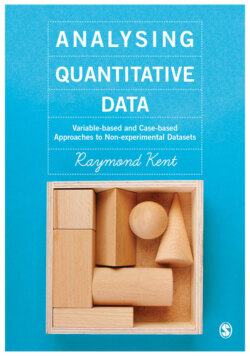Читать книгу Analysing Quantitative Data - Raymond A Kent - Страница 31
На сайте Литреса книга снята с продажи.
Coding
ОглавлениеAs was explained in Chapter 1, data analysis software usually requires that all the values to be entered are either already numerical (as in age = 23) or they are given a number that is a code that ‘stands for’ values that are in words. Binary variables will normally be coded either as 1 or 0 or as 1 or 2. The categories for nominal and ordered category variables will generally be numbered 1, 2, 3, 4, and so on. Note that it makes sense for ordered categories to give the highest code number to the highest or most positive value as in Figures 1.2 and 1.3 in Chapter 1. Metric data already have numerical values that can be entered directly, for example the number of units of alcohol consumed last week as 10.7. Some, perhaps all, of the categorical responses on a questionnaire will have been pre-coded, that is they are already numbered on the questionnaire. If not, they need to be coded afterwards by the researcher.
Qualitative responses to open-ended questions will normally be classified into categories, which are then coded. The categories developed should meet the minimum requirements for a binary or nominal measure, namely, they should be exhaustive, mutually exclusive and refer to a single dimension. If, however, most of the spaces left for text in the questionnaire have been left empty, it may not be worthwhile doing this. Some pre-coded questions may have an ‘Other, please specify’ category, in which case some further coding may be worthwhile.
If a question is unanswered, the researcher, when entering data into a survey analysis program, can record a missing value or enter a code for, for example, ‘Not applicable’ or ‘Refused to answer’. For multiple response questions where the respondent can indicate more than one category as applicable, each response category will need to be treated as a separate variable, and will usually be coded as 1 if the category is ticked and 0 or 2 if not. The treatment of open-ended and multiple response questions is considered in more detail later in this chapter.
In large-scale projects, and particularly when data entry is to be performed by a number of people or by subcontractors, researchers will often develop a codebook, which lists all the variable names (which are short, one-word identifiers), the variable labels (which are more extended descriptions of the variables and which appear as table or chart headings), the response categories used and the code numbers assigned. This means that any researcher can work on the dataset irrespective of whether or not they were involved in the project in its formative stages. Codebooks, however, are not always needed. Survey analysis packages like SPSS record all this information as part of the data matrix.
